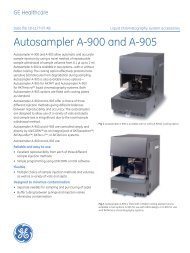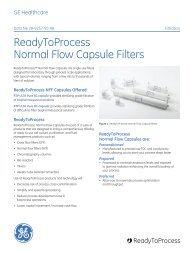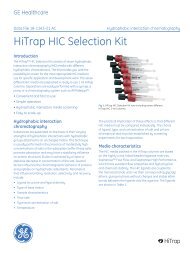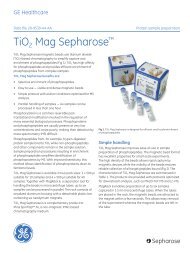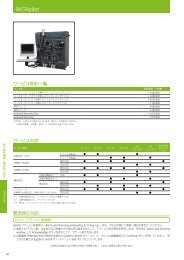[PDF] TALON Superflow and prepacked formats
[PDF] TALON Superflow and prepacked formats
[PDF] TALON Superflow and prepacked formats
Create successful ePaper yourself
Turn your PDF publications into a flip-book with our unique Google optimized e-Paper software.
GE Healthcare<br />
Life Sciences<br />
Data file 28-9664-10 AB<br />
Affinity chromatography<br />
<strong>TALON</strong> ® <strong>Superflow</strong> <strong>and</strong><br />
<strong>prepacked</strong> <strong>formats</strong><br />
<strong>TALON</strong> <strong>Superflow</strong> is a cobalt-based immobilized metal affinity<br />
chromatography medium (IMAC) offering enhanced selectivity<br />
for histidine-tagged proteins compared to nickel-charged<br />
media. <strong>TALON</strong> <strong>Superflow</strong> is available in 10 ml <strong>and</strong> 50 ml lab<br />
packs, <strong>and</strong> <strong>prepacked</strong> in a range of columns <strong>and</strong> 96-well<br />
plates. Prepacked HiTrap <strong>TALON</strong> crude, His GraviTrap<br />
<strong>TALON</strong>, His SpinTrap <strong>TALON</strong>, <strong>and</strong> His MultiTrap <strong>TALON</strong> (Fig<br />
1) enable different throughput <strong>and</strong> scales from screening in<br />
low microgram scale to milligram preparative purification of<br />
histidine-tagged recombinant proteins by IMAC.<br />
Key features:<br />
• Suitable for IMAC screening <strong>and</strong> purification of histidinetagged<br />
proteins when Ni 2+ is not the optimal choice of<br />
metal ion<br />
• Compatible with commonly used IMAC reagents <strong>and</strong><br />
appropriate for purifying proteins under native or<br />
denaturing conditions<br />
• HiTrap <strong>TALON</strong> crude <strong>and</strong> His GraviTrap <strong>TALON</strong> save time<br />
by allowing the application of unclarified samples directly,<br />
minimizing labor <strong>and</strong> degradation of proteins<br />
• His SpinTrap <strong>TALON</strong> <strong>and</strong> His MultiTrap <strong>TALON</strong> enable<br />
screening with highly reproducible results column-tocolumn<br />
<strong>and</strong> well-to-well<br />
• High purity in one step using a mild purification process<br />
that preserves structure <strong>and</strong> function of sensitive<br />
histidine-tagged proteins<br />
Description<br />
Direct loading of crude lysates<br />
All columns <strong>and</strong> 96-well plates <strong>prepacked</strong> with <strong>TALON</strong> <strong>Superflow</strong><br />
allow for rapid screening, purification, <strong>and</strong> easy scale-up, with<br />
a minimum of sample preparation <strong>and</strong> equipment. Figure 2<br />
illustrates time saved by simplified sample preparation through<br />
direct loading of unclarified samples.<br />
Fig 1. HiTrap <strong>TALON</strong> crude columns, His GraviTrap <strong>TALON</strong> columns,<br />
His SpinTrap <strong>TALON</strong> columns, His MultiTrap 96-well plates, <strong>and</strong><br />
<strong>TALON</strong> <strong>Superflow</strong> lab packs.<br />
Crude protocol<br />
Enzymatic<br />
<strong>and</strong><br />
mechanical<br />
cell lysis<br />
Enzymatic<br />
<strong>and</strong><br />
mechanical<br />
cell lysis<br />
Purification run<br />
40 min 40 min<br />
Conventional protocol<br />
Transfer<br />
the sample<br />
to tubes<br />
approx.<br />
80 min<br />
Centrifugation<br />
Collect the<br />
supernatant<br />
Filtration<br />
of sample<br />
Purification run<br />
40 min 40–80 min 40 min<br />
approx.<br />
120–160 min<br />
Fig 2. Schematic workflow showing the time saved in purifying histidine-tagged<br />
proteins using the crude protocol for HiTrap <strong>TALON</strong> crude <strong>and</strong> His GraviTrap <strong>TALON</strong><br />
columns compared to conventional protocol.<br />
imagination at work
The filters in the top <strong>and</strong> bottom of the columns <strong>and</strong> the<br />
bottom filter in the 96-well plate make it possible to directly<br />
load unclarified lysates without causing back pressure problems<br />
or leakage of the <strong>TALON</strong> <strong>Superflow</strong> beads. Prior to loading,<br />
the cell lysate should be prepared using enzymatic extraction<br />
buffers or mechanical methods such as sonication,<br />
homogenization, or freeze/thaw. Samples from several<br />
different expression systems can be applied directly to<br />
HiTrap <strong>TALON</strong> crude <strong>and</strong> His GraviTrap <strong>TALON</strong> columns after<br />
thorough cell disruption - without precentrifugation <strong>and</strong> filtration.<br />
His SpinTrap <strong>TALON</strong> <strong>and</strong> His MultiTrap <strong>TALON</strong> both allow direct<br />
loading of unclarified samples. However, clarification<br />
is recommended to achieve highest purity <strong>and</strong> recovery.<br />
<strong>TALON</strong> <strong>Superflow</strong><br />
<strong>TALON</strong> <strong>Superflow</strong> chromatography medium consists of<br />
highly cross-linked agarose beads with an immobilized<br />
chelating group. The characteristics of <strong>TALON</strong> <strong>Superflow</strong> are<br />
summarized in Table 1. The <strong>TALON</strong> lig<strong>and</strong> is a tetradentate<br />
chelator charged with Co 2+ ions. The medium binds<br />
polyhistidine-tagged proteins with high selectivity <strong>and</strong><br />
exhibits a reduced affinity for host proteins giving lower<br />
background. <strong>TALON</strong> <strong>Superflow</strong> allows protein purification<br />
under native or denaturing conditions <strong>and</strong> can be used<br />
with prokaryotic <strong>and</strong> eukaryotic expression systems. The<br />
medium is suitable for batch purification <strong>and</strong> can also be<br />
used for packing into liquid chromatography columns such<br />
as Tricorn or XK columns.<br />
<strong>TALON</strong> <strong>Superflow</strong> chromatography medium is compatible<br />
with commonly used aqueous buffers, denaturants, <strong>and</strong> a<br />
range of other additives (Table 2).<br />
Table 2. Compatible reagents for <strong>TALON</strong> <strong>Superflow</strong> 1, 2<br />
Reagent<br />
Acceptable concentration<br />
b-Mercaptoethanol 3<br />
10 mM (with caution)<br />
CHAPS, SDS, sarcosyl 4 1% (with caution)<br />
Ethanol 5 30%<br />
Ethylene glycol 30%<br />
HEPES<br />
50 mM<br />
Glycerol 20%<br />
Guanidinium hydrochloride 6 M<br />
Imidazole 6<br />
≤ 500 mM at pH 7.0 to 8.0, for elution<br />
KCl<br />
500 mM<br />
MES<br />
20 mM<br />
MOPS<br />
50 mM<br />
Sodium chloride<br />
1.0 M<br />
NP-40 1%<br />
Tris 7<br />
50 mM<br />
Triton-X 100 < 1%<br />
Urea<br />
8 M<br />
1<br />
Data provided by Clontech Laboratories, Inc.<br />
2<br />
EDTA <strong>and</strong> other chelators, such as EGTA, will strip Co 2+ ions from the medium; EDTA may be used, but<br />
must be removed prior to sample application. Strong reducing agents should also be avoided (e.g.,<br />
DTT, DTE, <strong>and</strong> TCEP) because they interfere with Co 2+ ions binding to the medium.<br />
3<br />
Use <strong>TALON</strong> <strong>Superflow</strong> immediately after equilibrating with buffers containing b-Mercaptoethanol,<br />
otherwise the medium will change color. Do not store the medium in buffers containing<br />
b-Mercaptoethanol.<br />
4<br />
Ionic detergents like CHAPS (3-[{3-Cholamidopropyl}-dimethylammonio]-1-propane-sulfonate),<br />
SDS (sodium dodecyl sulfate), <strong>and</strong> sarcosyl are compatible up to 1%. However, due to their charged<br />
nature, you should anticipate interference with binding.<br />
5<br />
Ethanol may precipitate proteins, causing low yields <strong>and</strong> column clogging.<br />
6<br />
Imidazole at concentrations higher than 5 to 10 mM may cause lower yields of histidine-tagged<br />
proteins because it competes with the histidine side chains (imidazole groups) for binding to the<br />
immobilized metal ions.<br />
7<br />
Tris coordinates weakly with metal ions, causing a decrease in capacity.<br />
Table 1. <strong>TALON</strong> <strong>Superflow</strong> characteristics<br />
Matrix Cross-linked agarose, 6%<br />
Precharged ion<br />
Cobalt<br />
Particle size distribution 60 to 160 μm<br />
Binding capacity 1<br />
up to 20 mg histidine-tagged<br />
protein/ml medium<br />
Maximum linear flow rate 2 2000 cm/h<br />
pH stability 3, 4<br />
Short term (2 h) 2 to 14<br />
Long term (1 wk) 3 to 12<br />
Storage 20% ethanol at 4ºC to 8ºC<br />
Compatibility during use Stable in all commonly used<br />
buffers, detanurants, <strong>and</strong> detergents<br />
(see Table 2)<br />
1<br />
The binding capacity for individual proteins may vary.<br />
2<br />
H 2<br />
O in a 0.75 × 10 cm (i.d. × H) column.<br />
3<br />
Co 2+ -stripped medium.<br />
4<br />
Below pH 4, metal ions will be stripped off the medium, <strong>and</strong> therefore neutral to slightly alkaline pH<br />
(pH 7 to 8) is recommended.<br />
HiTrap <strong>TALON</strong> crude columns<br />
HiTrap <strong>TALON</strong> crude columns can be operated with a syringe,<br />
peristaltic pump, or chromatography system such as<br />
ÄKTA systems. The columns are made of biocompatible<br />
polypropylene that does not interact with biomolecules.<br />
Columns are delivered with a stopper on the inlet <strong>and</strong> a<br />
snap-off end on the outlet. Note that HiTrap <strong>TALON</strong> crude<br />
columns cannot be opened or refilled. The characteristics of<br />
HiTrap <strong>TALON</strong> crude are summarized in Table 3.<br />
Table 3. HiTrap <strong>TALON</strong> crude characteristics<br />
Column volume<br />
1 ml <strong>and</strong> 5 ml<br />
Column dimensions, i.d. × H 0.7 × 2.5 cm (1 ml column)<br />
1.6 × 2.5 cm (5 ml column)<br />
Recommended flow rate 1 1 ml/min (1 ml column)<br />
5 ml/min (5 ml column)<br />
Maximum flow rate 1<br />
4 ml/min (1 ml column)<br />
20 ml/min (5 ml column)<br />
Column hardware pressure limit 2 0.5 MPa, 5 bar<br />
Chromatography medium <strong>TALON</strong> <strong>Superflow</strong> (see Table 1)<br />
1<br />
H 2<br />
O at room temperature.<br />
2<br />
The pressure over the packed bed varies depending on a range of parameters such as the<br />
characteristics of the chromatography medium <strong>and</strong> the column tubing used.<br />
2 28-9664-10 AB
His SpinTrap <strong>TALON</strong> columns<br />
His SpinTrap <strong>TALON</strong> columns (Fig 3) are excellent for screening<br />
of expression levels <strong>and</strong> purification conditions prior to scale<br />
up. The columns are designed for use in a microcentrifuge<br />
(Fig 4), <strong>and</strong> Figure 5 shows the rapid purification procedure<br />
using His SpinTrap <strong>TALON</strong>, taking approximately 10 min.<br />
The <strong>prepacked</strong> columns enable highly reproducible results<br />
column-to-column, with a relative sd
Equilibrate Load Sample Wash Elute<br />
Fig 8. A fast <strong>and</strong> simple four-stage process for purifying histidine-tagged<br />
proteins on His GraviTrap <strong>TALON</strong>.<br />
Table 4. His GraviTrap <strong>TALON</strong>, His SpinTrap <strong>TALON</strong> <strong>and</strong> His MultiTrap <strong>TALON</strong><br />
characteristics<br />
Column <strong>and</strong> 96-well plate<br />
material<br />
Protein binding capacity 1<br />
Polypropylene barrel <strong>and</strong> plate,<br />
polyethylene frits<br />
- His GraviTrap <strong>TALON</strong> Up to 15 mg histidine-tagged<br />
protein/column<br />
- His SpinTrap <strong>TALON</strong> Up to 1 mg histidine-tagged<br />
protein/column<br />
- His MultiTrap <strong>TALON</strong> Up to 1 mg histidine-tagged<br />
protein/well<br />
Bed volume in columns/wells<br />
- His GraviTrap <strong>TALON</strong> 1 ml/column<br />
- His SpinTrap <strong>TALON</strong> 100 µl/column<br />
- His MultiTrap <strong>TALON</strong> 50 µl/well (500 µl of 10% slurry)<br />
Total volume in columns/wells<br />
- His GraviTrap <strong>TALON</strong> 13.5 ml<br />
- His SpinTrap <strong>TALON</strong> 1000 µl<br />
- His MultiTrap <strong>TALON</strong> 800 µl<br />
Reproducibility column-to ±10%<br />
column, plate-to-plate<br />
<strong>and</strong> well-to-well<br />
Filter plate size of<br />
His MultiTrap <strong>TALON</strong><br />
127.8 × 85.5 × 30.6 mm<br />
according to ANSI/SBS 1-2004,<br />
3-2004 <strong>and</strong> 4-2004 st<strong>and</strong>ards<br />
Number of wells 96<br />
Avoid in buffers<br />
Chelating agents, e.g. EDTA, EGTA,<br />
citrate <strong>and</strong> DTT, DTE, <strong>and</strong> TCEP<br />
1<br />
The binding capacity for individual proteins may vary.<br />
Applications<br />
Yield <strong>and</strong> purity using unclarified vs clarified sample<br />
HiTrap <strong>TALON</strong> crude columns simplify purification by<br />
eliminating the need for precentrifugation <strong>and</strong> filtration steps.<br />
For comparison, unclarified <strong>and</strong> clarified (centrifugation at<br />
30 000 × g for 20 min) E. coli extracts containing the histidinetagged<br />
protein GEHC1-(His) 6<br />
were loaded on HiTrap <strong>TALON</strong><br />
crude 1 ml columns. After purification, purity (analyzed<br />
by SDS-PAGE) <strong>and</strong> yield (calculated from absorbance<br />
measurements) of eluted fraction pools were determined.<br />
Figure 9 shows that purification using unclarified extract<br />
was similar to when clarified sample was used. The amount<br />
of GEHC1-(His) 6<br />
eluted was 13 <strong>and</strong> 12 mg when loading<br />
unclarified <strong>and</strong> clarified sample, respectively. In addition,<br />
the purity did not significantly differ <strong>and</strong> SDS-PAGE analysis<br />
showed high purity for both samples (> 90%; Fig 10). By<br />
eliminating the need for precentrifugation <strong>and</strong> filtration,<br />
HiTrap <strong>TALON</strong> crude columns save approximately 40 min.<br />
Column:<br />
HiTrap <strong>TALON</strong> crude 1 ml<br />
Sample: Unclarified <strong>and</strong> clarified E. coli lysate containing GEHC1-(His) 6<br />
(M r<br />
47 000)<br />
Sample volume: 20 ml<br />
Binding/wash buffer: 50 mM NaH 2<br />
PO 4<br />
, 300 mM NaCl, 5 mM imidazole, pH 7.4<br />
Elution buffer: 50 mM NaH 2<br />
PO 4<br />
, 300 mM NaCl, 150 mM imidazole, pH 7.4<br />
Flow rate:<br />
1 ml/min<br />
Detection:<br />
Absorbance, 280 nm<br />
System:<br />
ÄKTA<br />
A 280 (mAU)<br />
1000<br />
800<br />
600<br />
400<br />
200<br />
Unclarified sample<br />
Clarified sample<br />
Elution buffer<br />
0<br />
0<br />
0 10 20 30 40 50<br />
Volume (ml)<br />
Fig 9. Comparison study loading unclarified (blue line) <strong>and</strong> clarified (orange<br />
line) E. coli samples containing the histidine-tagged protein GEHC1-(His) 6<br />
on<br />
HiTrap <strong>TALON</strong> crude. Overlay of absorbance curves.<br />
M r × 10 3<br />
97.0<br />
66.0<br />
45.0<br />
4.0<br />
3.5<br />
3.0<br />
2.5<br />
2.0<br />
1.5<br />
1.0<br />
0.5<br />
1. LMW-SDS Marker Kit<br />
2. Start material, unclarified<br />
3. Pool purified protein,<br />
unclarified<br />
4. Start material, clarified<br />
5. Pool purified protein,<br />
clarified<br />
Pressure (MPa)<br />
30.0<br />
20.1<br />
14.4<br />
1 2 3 4 5<br />
Fig 10. SDS-PAGE analysis (reducing conditions, ExcelGel SDS Gradient 8-18,<br />
Coomassie stained) of pools containing purified GEHC1-(His) 6<br />
. Comparison of<br />
runs performed on HiTrap <strong>TALON</strong> crude using unclarified <strong>and</strong> clarified sample.<br />
4 28-9664-10 AB
Repeated purification runs possible without<br />
regeneration of HiTrap <strong>TALON</strong> crude<br />
Reproducibility of HiTrap <strong>TALON</strong> crude columns in terms of<br />
purity <strong>and</strong> recovery over a number of repeated runs without<br />
stripping, cleaning, or Co 2+ recharging was investigated. In this<br />
study, GEHC1-(His) 6<br />
was purified from an unclarified lysate of<br />
E. coli in four consecutive runs (Fig 11). The yield (calculated<br />
from absorbance measurements) was reproducible, as shown<br />
in Figure 12, <strong>and</strong> the back pressure did not increase during<br />
the four purification runs. The purity, determined by SDS-PAGE<br />
analysis, was high for all purification cycles (> 90%; Fig 13).<br />
Column:<br />
HiTrap <strong>TALON</strong> crude 1 ml<br />
Sample: Unclarified E.coli lysate containing GEHC1-(His) 6<br />
(M r<br />
47 000),<br />
prepared by homogenization<br />
Sample volume: 20 ml<br />
Binding/wash buffer: 50 mM NaH 2<br />
PO 4<br />
, 300 mM NaCl, 5 mM imidazole, pH 7.4<br />
Elution buffer: 50 mM NaH 2<br />
PO 4<br />
, 300 mM NaCl, 150 mM imidazole, pH 7.4<br />
Flow rate:<br />
1 ml/min<br />
System:<br />
ÄKTA<br />
Detection:<br />
Absorbance, 280 nm<br />
Amount (mg)<br />
15<br />
10<br />
5<br />
0<br />
1 2 3 4<br />
Run<br />
Fig 12. Four purification cycles, run consecutively without regenerating the<br />
medium in between cycles, gave consistent <strong>and</strong> reproducible yields.<br />
M r × 10 3<br />
97.0<br />
66.0<br />
45.0<br />
30.0<br />
20.1<br />
41.0 42.0 43.0 44.0 45.0 Volume<br />
14.4<br />
600<br />
500<br />
3.0<br />
2.5<br />
1 2 3 4 5 6 7<br />
A 280 (mAU)<br />
400<br />
300<br />
200<br />
100<br />
0<br />
0 10 20 30 40 50<br />
Volume (ml)<br />
Fig 11. Overlaid chromatograms from four consecutive purification cycles<br />
loading unclarified E.coli lysate containing GEHC1-(His) 6<br />
on HiTrap <strong>TALON</strong> crude<br />
without cleaning <strong>and</strong> regeneration in between cycles. Pressure curves for<br />
run 1 (green) <strong>and</strong> run 4 (orange) are also shown. A close-up of the eluted peak<br />
shows high reproducibility between the runs.<br />
2.0<br />
1.5<br />
1.0<br />
0.5<br />
0<br />
Pressure (MPa)<br />
1. LMW-SDS Marker Kit<br />
2. Start material<br />
3. Pool elution, run 1<br />
4. Pool elution, run 2<br />
5. Pool elution, run 3<br />
6. Pool elution, run 4<br />
7. LMW-SDS Marker Kit<br />
Fig 13. SDS-PAGE analysis (reducing conditions, ExcelGel SDS Gradient<br />
8-18, Coomassie stained) of pools containing purified GEHC1-(His) 6<br />
from<br />
four consecutive purification runs on a HiTrap <strong>TALON</strong> crude 1 ml column.<br />
High purity was obtained for all four purification runs performed on<br />
HiTrap <strong>TALON</strong> crude without recharging <strong>and</strong> cleaning in between runs.<br />
28-9664-10 AB 5
Increased purity of a kinase using gradient elution<br />
The imidazole concentration in binding <strong>and</strong> wash buffer is<br />
critical for obtaining as high purity <strong>and</strong> yield as possible. The<br />
optimal imidazole concentration depends on the protein, <strong>and</strong><br />
increasing imidazole concentration will increase purity but<br />
can also decrease the yield. Normally, low concentrations<br />
of imidazole are used in binding/wash buffers <strong>and</strong> in the<br />
sample, to minimize binding of host cell proteins.<br />
Elution by using an imidazole gradient is an efficient approach<br />
for obtaining high purity of histidine-tagged proteins. This<br />
is clearly demonstrated in a study of a histidine-tagged<br />
kinase, ERK3-(His) 6<br />
, purified on HiTrap <strong>TALON</strong> crude 1 ml. Two<br />
different purification approaches were used, linear gradient<br />
elution <strong>and</strong> step elution (Fig 14A <strong>and</strong> 14B, respectively).<br />
No optimization was performed prior to the step elution.<br />
Fractions were analyzed by SDS-PAGE (Fig 14C). Figure 14C<br />
shows that the eluted fraction from the step elution<br />
contained impurities, while eluted fractions from the gradient<br />
elution demonstrated increased purity.<br />
Column:<br />
HiTrap <strong>TALON</strong> crude 1 ml<br />
Sample:<br />
Unclarified E.coli BL21 containing ERK3-(His) 6<br />
(M r<br />
38 300), prepared by sonication<br />
Sample volume: 20 ml<br />
Binding/wash buffer: 50 mM NaH 2<br />
PO 4<br />
, 300 mM NaCl, pH 7.4<br />
Elution buffer: 50 mM NaH 2<br />
PO 4<br />
, 300 mM NaCl, pH 7.4<br />
A): Gradient, 0 to 150 mM imidazole<br />
B): Step, 150 mM imidazole<br />
Flow rate:<br />
1 ml/min<br />
System:<br />
ÄKTA<br />
Detection:<br />
Absorbance, 280 nm<br />
A)<br />
3000<br />
100<br />
B)<br />
3000<br />
100<br />
2500<br />
80<br />
2500<br />
80<br />
A 280 (mAU)<br />
2000<br />
1500<br />
1000<br />
60<br />
40<br />
Elution buffer (%)<br />
A 280 (mAU)<br />
2000<br />
1500<br />
1000<br />
60<br />
40<br />
Elution buffer (%)<br />
500<br />
20<br />
500<br />
20<br />
0<br />
0<br />
0<br />
0 10 20 30 40 50 60 70<br />
0 10 20 30 40 50<br />
Volume (ml)<br />
Volume (ml)<br />
0<br />
C)<br />
Gradient elution<br />
Imidazole concentration (mM)<br />
Step elution<br />
Imidazole concentration (mM)<br />
M r × 10 3<br />
M S 19 27 35 43 51<br />
59 66 74 82 90 M S 150<br />
97.0<br />
66.0<br />
45.0<br />
30.0<br />
20.1<br />
14.4<br />
Fig 14. Purification of ERK3-(His) 6<br />
in unclarified E.coli sonicate using HiTrap <strong>TALON</strong> crude 1 ml. A) Protein was eluted using a 20 column volume (CV) linear<br />
imidazole gradient (0 to 150 mM imidazole). B) Protein was eluted using 8 CV step elution (150 mM imidazole). C) SDS-PAGE analysis (reducing conditions,<br />
ExcelGel SDS Gradient 8-18, Deep Purple stained) of start material <strong>and</strong> eluted fractions (M = LMW-SDS Marker Kit; S = start material). The gel was scanned<br />
using Ettan DIGE Imager fluorescence scanner. The imidazole concentration during elution is shown for each eluate.<br />
6 28-9664-10 AB
Simple <strong>and</strong> rapid protein purification using<br />
His GraviTrap <strong>TALON</strong><br />
His GraviTrap <strong>TALON</strong> enables fast <strong>and</strong> easy manual purification<br />
of histidine-tagged proteins without the need of a purification<br />
system. Using a gravity-flow protocol, histidine-tagged green<br />
fluorescent protein (GFP-His) added to E. coli lysate was<br />
purified with His GraviTrap <strong>TALON</strong> in less than 30 min (Table 5).<br />
The recovery was calculated using absorbance measurements<br />
<strong>and</strong> was found to be 95%, with 96% of the purified protein<br />
eluting in the first elution fraction. Figure 15 shows the SDS-PAGE<br />
analysis of the first <strong>and</strong> second elution fractions. The results<br />
indicate a purity of ≥ 93% for the purified GFP-His protein.<br />
Table 5. Experimental conditions for His GraviTrap <strong>TALON</strong><br />
Column<br />
His GraviTrap <strong>TALON</strong><br />
Sample<br />
GFP-His (1 mg/ml) added to E. coli lysate,<br />
prepared by enzymatic lysis <strong>and</strong> sonication<br />
Sample volume 8 ml<br />
Binding buffer 50 mM NaH 2<br />
PO 4<br />
, 300 mM NaCl, pH 7.4<br />
Wash buffer 50 mM NaH 2<br />
PO 4<br />
, 300 mM NaCl,<br />
5 mM imidazole, pH 7.4<br />
Elution buffer 50 mM NaH 2<br />
PO 4<br />
, 300 mM NaCl,<br />
150 mM imidazole, pH 7.4<br />
First<br />
elution fraction<br />
Second<br />
elution fraction<br />
Comparison of purity achieved using various<br />
gravity flow columns<br />
A comparative analysis of the recovery <strong>and</strong> purity achieved<br />
when purifying GFP-His added to E. coli lysate was performed<br />
at GE Healthcare laboratories in order to investigate the<br />
differences in performance between three different gravity<br />
flow columns. His GraviTrap <strong>TALON</strong> (<strong>TALON</strong> <strong>Superflow</strong> medium)<br />
<strong>and</strong> His GraviTrap (Nickel Sepharose 6 Fast Flow medium),<br />
both from GE Healthcare, were compared with HisPur<br />
Cobalt Spin Column from Thermo Scientific (Table 6).<br />
Purification of clarified GFP-His added to E. coli lysate was<br />
executed in triplicate according to each manufacturer’s<br />
gravity protocol, <strong>and</strong> the results showed that the recovery<br />
was high at ≥95% for all columns. Figure 16 displays the<br />
degree of purity estimated by SDS-PAGE analysis of the<br />
eluted fraction containing the most purified protein, showing<br />
that the highest purity was achieved using His GraviTrap <strong>TALON</strong>.<br />
Purity %<br />
100<br />
80<br />
60<br />
40<br />
M r<br />
× 10 3<br />
1 2 3 4 5 6 7<br />
8<br />
20<br />
97.0<br />
66.0<br />
45.0<br />
30.0<br />
20.1<br />
14.4<br />
GFP-His<br />
0<br />
His GraviTrap <strong>TALON</strong><br />
GE Healthcare<br />
HisPur Cobalt<br />
Spin Column,<br />
Thermo Scientific<br />
His GraviTrap,<br />
GE Healthcare<br />
Fig 16. Purification of GFP-His added to E. coli lysate with three replicates<br />
using three different gravity-flow columns. SDS-PAGE gel electrophoresis was<br />
used to determine the degree of purity (Fig 17). Using the Student's t-test, the<br />
differences in purity between His GraviTrap <strong>TALON</strong> <strong>and</strong> His GraviTrap <strong>and</strong><br />
HisPur Cobalt Spin Column respectively were statistically significant (p < 0.05,<br />
df = 4). The st<strong>and</strong>ard error of the mean is shown as error bars.<br />
1 2 3 4 5<br />
1. LMW-SDS Marker Kit<br />
M r<br />
× 10 3<br />
2. Start material, diluted 50-fold<br />
3. Replicate 1<br />
97.0<br />
4. Replicate 2<br />
5. Replicate 3<br />
66.0<br />
6. Replicate 1<br />
7. Replicate 2<br />
45.0<br />
8. Replicate 3 1. LMW-SDS Marker Kit<br />
30.0<br />
2. Start material, diluted 50-fold<br />
Fig 15. SDS-PAGE analysis of elution fractions from a purification of GFP-His<br />
(M r<br />
28 000) added to E. coli lysate. The SDS-PAGE gel (reducing conditions)<br />
20.1<br />
3. His GraviTrap <strong>TALON</strong>, GE Healthcare<br />
was stained with Deep Purple Total Protein Stain <strong>and</strong> analyzed with<br />
4. HisPur Cobalt spin column,<br />
14.4<br />
ImageQuant TL software. The experiment was performed in triplicate.<br />
Thermo Scientific<br />
5. His GraviTrap, GE Healthcare<br />
Fig 17. SDS-PAGE analysis of elution fractions from the purification of GFP-His<br />
(M r<br />
28 000) added to E. coli using three different gravity-flow columns. The<br />
SDS-PAGE gel (reducing conditions) was stained with Deep Purple Total<br />
Protein Stain <strong>and</strong> analyzed with ImageQuant TL software.<br />
28-9664-10 AB 7
Table 6. Experimental conditions for purification using gravity flow columns from GE Healthcare <strong>and</strong> Thermo Scientific<br />
Supplier GE Healthcare GE Healthcare Thermo Scientific<br />
Column His GraviTrap <strong>TALON</strong> His GraviTrap HisPur Cobalt Spin Column<br />
Medium volume 1 ml 1 ml 1 ml<br />
Sample<br />
GFP-His (0.5 mg/ml) added to E. coli lysate, prepared by enzymatic lysis <strong>and</strong> sonication followed by clarification<br />
through centrifugation<br />
Sample volume 10 ml 10 ml 10 ml<br />
Binding buffer<br />
Wash buffer<br />
Elution buffer<br />
50 mM NaH 2<br />
PO 4<br />
, 300 mM NaCl, pH 7.4 20 mM NaH 2<br />
PO 4<br />
, 500 mM NaCl,<br />
20 mM imidazole, pH 7.4<br />
50 mM NaH 2<br />
PO 4<br />
, 300 mM NaCl,<br />
5 mM imidazole, pH 7.4<br />
50 mM NaH 2<br />
PO 4<br />
, 300 mM NaCl,<br />
150 mM imidazole, pH 7.4<br />
20 mM NaH 2<br />
PO 4<br />
, 500 mM NaCl,<br />
20 mM imidazole, pH 7.4<br />
20 mM NaH 2<br />
PO 4<br />
, 500 mM NaCl,<br />
500 mM imidazole, pH 7.4<br />
50 mM NaH 2<br />
PO 4<br />
, 300 mM NaCl,<br />
10 mM imidazole, pH 7.4<br />
50 mM NaH 2<br />
PO 4<br />
, 300 mM NaCl,<br />
10 mM imidazole, pH 7.4<br />
50 mM NaH 2<br />
PO 4<br />
, 300 mM NaCl,<br />
150 mM imidazole, pH 7.4<br />
Repeatable purification using His SpinTrap <strong>TALON</strong><br />
One advantage of His SpinTrap <strong>TALON</strong> is the possibility to<br />
perform several purifications both simultaneously <strong>and</strong> with<br />
high repeatability. In order to investigate the repeatability,<br />
unclarified GFP-His added to E. coli lysate was loaded onto<br />
ten His SpinTrap <strong>TALON</strong> columns <strong>and</strong> centrifuged (Table 7).<br />
Figure 18 shows high purity (>90%) of the eluted GFP-His.<br />
Recovery was calculated with absorbance measurements<br />
<strong>and</strong> found to be highly repeatable with an average of 71 %<br />
recovered <strong>and</strong> a relative st<strong>and</strong>ard deviation (RSD) of 6%.<br />
Table 7. Experimental conditions for His SpinTrap <strong>TALON</strong><br />
Column<br />
His SpinTrap <strong>TALON</strong><br />
Sample<br />
Unclarified GFP-His (1 mg/ml) added to E. coli<br />
lysate, prepared by enzymatic lysis <strong>and</strong> sonication<br />
Sample volume 500 µl<br />
Binding buffer 50 mM NaH 2<br />
PO 4<br />
, 300 mM NaCl, pH 7.4<br />
Wash buffer 50 mM NaH 2<br />
PO 4<br />
, 300 mM NaCl,<br />
5 mM imidazole, pH 7.4<br />
Elution buffer 50 mM NaH 2<br />
PO 4<br />
, 300 mM NaCl,<br />
150 mM imidazole, pH 7.4<br />
Centrifugal force 100 × g for 30 s<br />
System<br />
Centrifuge 5415R Eppendorf<br />
LMW First elution fraction replicates 1-10 Second elution fraction replicates 1-10<br />
M r<br />
× 10 3<br />
97.0<br />
45.0<br />
30.0<br />
14.4<br />
Fig 18. SDS-PAGE analysis of elution fractions from ten replicate purification runs of GFP-His (M r<br />
28 000) using His SpinTrap <strong>TALON</strong>. The SDS-PAGE gel<br />
(reducing conditions) was stained with Deep Purple Total Protein Stain <strong>and</strong> analyzed with ImageQuant TL software. LMW = LMW-SDS Marker Kit.<br />
8 28-9664-10 AB
Comparison of His SpinTrap, His SpinTrap <strong>TALON</strong>,<br />
<strong>and</strong> HisPur Cobalt Spin Columns<br />
To investigate the differences in performance between three<br />
different spin columns, a comparative analysis was performed<br />
at GE Healthcare laboratories with regards to recovery <strong>and</strong><br />
purity achieved when purifying GFP-His added to E. coli lysate.<br />
His SpinTrap <strong>TALON</strong> (<strong>TALON</strong> <strong>Superflow</strong> medium) <strong>and</strong> His<br />
SpinTrap (Nickel Sepharose 6 Fast Flow medium), both from<br />
GE Healthcare, were compared with HisPur Cobalt Spin Column<br />
from Thermo Scientific (Table 8). Purification of clarified<br />
GFP-His added to E. coli lysate was performed according to<br />
each manufacturer’s protocol, <strong>and</strong> the results displayed in<br />
Figure 20A show that the highest recovery was achieved<br />
using His SpinTrap (93%), whereas His SpinTrap <strong>TALON</strong> <strong>and</strong><br />
HisPur Cobalt Spin Column gave a recovery of 82% <strong>and</strong><br />
76% respectively. Figure 20B shows that the purity was<br />
approximately equal for His SpinTrap <strong>TALON</strong> <strong>and</strong> His Cobalt<br />
Spin Column (85% <strong>and</strong> 83% respectively), whereas it was<br />
significantly lower (70%) for His SpinTrap.<br />
M r<br />
× 10 3<br />
97.0<br />
66.0<br />
45.0<br />
30.0<br />
His SpinTrap,<br />
GE Healthcare<br />
HisPur Cobalt<br />
Spin Column,<br />
Thermo Scientific<br />
20.1<br />
14.4<br />
1. LMW-SDS Marker Kit<br />
2. Start material, diluted 50-fold<br />
3. Elution 1<br />
4. Elution 2<br />
5. Elution 1<br />
His SpinTrap<br />
<strong>TALON</strong>,<br />
GE Healthcare<br />
1 2 3 4 5 6 7 8 9<br />
6. Elution 2<br />
7. Elution 3<br />
8. Elution 1<br />
9. Elution 2<br />
Fig 19. SDS-PAGE analysis of elution fractions from the purification of GFP-His<br />
(M r<br />
28 000). The SDS-PAGE gel (reducing conditions) was stained with Deep<br />
Purple Total Protein Stain <strong>and</strong> analyzed with ImageQuant TL software.<br />
B)<br />
A)<br />
Reocovery Reocovery % %<br />
Purity % Purity %<br />
100<br />
100<br />
80<br />
80<br />
60<br />
60<br />
40<br />
40<br />
20<br />
20<br />
0<br />
0<br />
100<br />
100<br />
80<br />
80<br />
60<br />
60<br />
40<br />
40<br />
20<br />
20<br />
0<br />
0<br />
His SpinTrap,<br />
GE Healthcare<br />
His SpinTrap,<br />
GE Healthcare<br />
His SpinTrap <strong>TALON</strong>,<br />
GE Healthcare<br />
His SpinTrap <strong>TALON</strong>,<br />
GE Healthcare<br />
His SpinTrap <strong>TALON</strong>,<br />
GE Healthcare<br />
His SpinTrap <strong>TALON</strong>,<br />
GE Healthcare<br />
HisPur Cobalt<br />
Spin Columns,<br />
Thermo HisPur Scientific Cobalt<br />
Spin Columns,<br />
Thermo Scientific<br />
HisPur Cobalt<br />
Spin Column,<br />
Thermo HisPur Scientific Cobalt<br />
Spin Column,<br />
Thermo Scientific<br />
His SpinTrap,<br />
GE Healthcare<br />
His SpinTrap,<br />
GE Healthcare<br />
Elution 3<br />
Elution 2<br />
Elution 13<br />
Elution 2<br />
Elution 1<br />
Fig 20. GFP-His added to E. coli lysate using three different spin columns.<br />
500 µl GFP-His was loaded onto each column <strong>and</strong> the experiment was<br />
performed in triplicate. A) Recovery was calculated using absorbance<br />
measurements. The colors of the bars represent the amount of protein<br />
eluted in each fraction. In accordance with the protocol supplied from<br />
Thermo Scientific, elution was performed three times for the HisPur Cobalt<br />
Spin Columns. B) SDS-PAGE gel electrophoresis was used to determine<br />
purity (Fig 19). Using Student's t-test, the differences in recovery between<br />
His SpinTrap <strong>TALON</strong> <strong>and</strong> His SpinTrap <strong>and</strong> HisPur Cobalt Spin Column<br />
respectively were statistically significant (p < 0.05, df = 4). Using the same<br />
test with regards to purity confirmed statistically significant differences<br />
between His SpinTrap <strong>TALON</strong> <strong>and</strong> His SpinTrap, but not between His<br />
SpinTrap <strong>TALON</strong> <strong>and</strong> HisPur Cobalt Spin Column. The st<strong>and</strong>ard error of the<br />
mean is shown as error bars.<br />
Table 8. Experimental conditions for purification using spin columns from GE Healthcare <strong>and</strong> Thermo Scientific<br />
Supplier GE Healthcare GE Healthcare Thermo Scientific<br />
Column His SpinTrap <strong>TALON</strong> His SpinTrap HisPur Cobalt Spin Column<br />
Medium volume 100 µl 100 µl 200 µl<br />
Sample<br />
GFP-His (1 mg/ml) added to E. coli lysate, prepared by enzymatic lysis <strong>and</strong> sonication followed by clarification<br />
through centrifugation<br />
Sample volume 500 µl 500 µl 500 µl<br />
Binding buffer 50 mM NaH 2<br />
PO 4<br />
, 300 mM NaCl, pH 7.4 20 mM NaH 2<br />
PO 4<br />
, 500 mM NaCl,<br />
20 mM imidazole, pH 7.4<br />
Wash buffer<br />
Elution buffer<br />
50 mM NaH 2<br />
PO 4<br />
, 300 mM NaCl,<br />
5 mM imidazole, pH 7.4<br />
50 mM NaH 2<br />
PO 4<br />
, 300 mM NaCl,<br />
150 mM imidazole, pH 7.4<br />
20 mM NaH 2<br />
PO 4<br />
, 500 mM NaCl,<br />
20 mM imidazole, pH 7.4<br />
20 mM NaH 2<br />
PO 4<br />
, 500 mM NaCl,<br />
500 mM imidazole, pH 7.4<br />
50 mM NaH 2<br />
PO 4<br />
, 300 mM NaCl,<br />
10 mM imidazole, pH 7.4<br />
50 mM NaH 2<br />
PO 4<br />
, 300 mM NaCl,<br />
10 mM imidazole, pH 7.4<br />
50 mM NaH 2<br />
PO 4<br />
, 300 mM NaCl,<br />
150 mM imidazole, pH 7.4<br />
Centrifugal force 100 × g for 30 s 100 × g for 30 s 700 × g for 2 min<br />
System Centrifuge 5415R Eppendorf Centrifuge 5415R Eppendorf Centrifuge 5415R Eppendorf<br />
28-9664-10 AB 9
Comparison of Cobalt <strong>and</strong> Nickel IMAC media<br />
using His MultiTrap <strong>TALON</strong> <strong>and</strong> His MultiTrap FF<br />
In any comparison between different purification media,<br />
recovery <strong>and</strong> purity depend on the protein to be purified.<br />
Keeping this in mind, one of the benefits of Cobalt IMAC<br />
medium compared to Nickel IMAC medium is that it often<br />
results in higher purity, even though it uses milder conditions<br />
during both purification <strong>and</strong> elution. Nickel IMAC medium, on<br />
the other h<strong>and</strong>, often delivers better recovery at the cost of<br />
harsher purification conditions.<br />
To investigate the differences in performance between<br />
96-well plates with Nickel IMAC medium <strong>and</strong> Cobalt IMAC<br />
medium, multiple purifications were performed using His<br />
MultiTrap FF (Nickel Sepharose 6 Fast Flow medium) with<br />
two separate protocols differing in binding buffer imidazole<br />
concentration, <strong>and</strong> His MultiTrap <strong>TALON</strong> (<strong>TALON</strong> <strong>Superflow</strong><br />
medium) using no imidazole in the binding buffer.<br />
His MultiTrap<br />
<strong>TALON</strong><br />
His MultiTrap FF<br />
40 mM imidazole<br />
His MultiTrap FF<br />
20 mM imidazole<br />
During the elution, the imidazole concentration was 500 mM<br />
for His MultiTrap FF <strong>and</strong> 150 mM for His MultiTrap <strong>TALON</strong>.<br />
GFP-His added to E. coli lysate was loaded onto the wells of<br />
the His MultiTrap FF plate <strong>and</strong> the His MultiTrap <strong>TALON</strong> plate<br />
respectively (Table 9). The results presented in Figure 22 show<br />
that the highest recovery was achieved with His MultiTrap FF<br />
using the lower concentration of imidazole, whereas the<br />
purest elution fractions were obtained with His MultiTrap <strong>TALON</strong>.<br />
A)<br />
Reocovery %<br />
100<br />
80<br />
60<br />
40<br />
20<br />
M r<br />
× 10 3<br />
1 2 3 4 5 6 7 8 9 10 11<br />
0<br />
His Multitrap FF,<br />
20 mM imidazole in<br />
binding <strong>and</strong> wash buffer<br />
His Multitrap FF,<br />
40 mM imidazole in<br />
binding <strong>and</strong> wash buffer<br />
His Multitrap <strong>TALON</strong><br />
97.0<br />
66.0<br />
45.0<br />
B)<br />
100<br />
80<br />
30.0<br />
20.1<br />
14.4<br />
Purity %<br />
60<br />
40<br />
1. LMW-SDS Marker Kit<br />
2. Start material<br />
3. Elution 1<br />
4. Elution 2<br />
5. Elution 3<br />
6. Elution 1<br />
7. Elution 2<br />
8. Elution 3<br />
9. Elution 1<br />
10. Elution 2<br />
11. Elution 3<br />
Fig 21. SDS-PAGE analysis of elution fractions from the purification of GFP-His<br />
(M r<br />
28 000) using His MultiTrap <strong>TALON</strong> <strong>and</strong> His MultiTrap FF. The SDS-PAGE<br />
gel (reducing conditions) was stained with Deep Purple Total Protein Stain<br />
<strong>and</strong> analyzed with ImageQuant TL software.<br />
20<br />
0<br />
His Multitrap FF,<br />
20 mM imidazole in<br />
binding <strong>and</strong> wash buffer<br />
His Multitrap FF,<br />
40 mM imidazole in<br />
binding <strong>and</strong> wash buffer<br />
His Multitrap <strong>TALON</strong><br />
Fig 22. Purification of GFP-His added to E. coli lysate using His MultiTrap <strong>TALON</strong><br />
<strong>and</strong> His MultiTrap FF. A) Recovery was calculated based on absorbance<br />
measurements, <strong>and</strong> B) SDS-PAGE gel electrophoresis was used to determine<br />
purity (Fig 21).<br />
Table 9. Experimental conditions for purification using His MultiTrap <strong>TALON</strong> <strong>and</strong> His MultiTrap FF<br />
96-well plate His MultiTrap <strong>TALON</strong> His MultiTrap FF His MultiTrap FF<br />
No of samples 96 (1 plate) 48 (½ plate) 48 (½ plate)<br />
Sample<br />
GFP-His (0.5 mg/ml) added to E. coli lysate, prepared by enzymatic lysis <strong>and</strong> sonication followed by clarification through<br />
centrifugation<br />
Sample volume 500 µl 500 µl 500 µl<br />
Binding buffer 50 mM NaH 2<br />
PO 4<br />
, 300 mM NaCl, pH 7.4 20 mM NaH 2<br />
PO 4<br />
, 500 mM NaCl,<br />
20 mM imidazole, pH 7.4<br />
Wash buffer<br />
Elution buffer<br />
50 mM NaH 2<br />
PO 4<br />
, 300 mM NaCl,<br />
5 mM imidazole, pH 7.4<br />
50 mM NaH 2<br />
PO 4<br />
, 300 mM NaCl,<br />
150 mM imidazole, pH 7.4<br />
20 mM NaH 2<br />
PO 4<br />
, 500 mM NaCl,<br />
20 mM imidazole, pH 7.4<br />
20 mM NaH 2<br />
PO 4<br />
, 500 mM NaCl,<br />
500 mM imidazole, pH 7.4<br />
20 mM NaH 2<br />
PO 4<br />
, 500 mM NaCl,<br />
40 mM imidazole, pH 7.4<br />
20 mM NaH 2<br />
PO 4<br />
, 500 mM NaCl,<br />
40 mM imidazole, pH 7.4<br />
20 mM NaH 2<br />
PO 4<br />
, 500 mM NaCl,<br />
500 mM imidazole, pH 7.4<br />
Pressure -0.15 to -0.30 bar -0.15 to -0.30 bar -0.15 to -0.30 bar<br />
System Vacuum regulator IRV3000-FO2 SMC Vacuum regulator IRV3000-FO2 SMC Vacuum regulator IRV3000-FO2 SMC<br />
10 28-9664-10 AB
Ordering information<br />
Product Quantity Code number<br />
HiTrap <strong>TALON</strong> crude 5 × 1 ml 28-9537-66<br />
HiTrap <strong>TALON</strong> crude 100 × 1 ml 1 28-9538-05<br />
HiTrap <strong>TALON</strong> crude 5 × 5 ml 28-9537-67<br />
HiTrap <strong>TALON</strong> crude 100 × 5 ml 1 28-9538-09<br />
<strong>TALON</strong> <strong>Superflow</strong> 10 ml 28-9574-99<br />
<strong>TALON</strong> <strong>Superflow</strong> 50 ml 28-9575-02<br />
His SpinTrap <strong>TALON</strong> 50 x 0.1 ml 29-0005-93<br />
His GraviTrap <strong>TALON</strong> 10 x 1 ml 29-0005-94<br />
His MultiTrap <strong>TALON</strong><br />
4 x 96-well<br />
plates<br />
29-0005-96<br />
Related literature<br />
Code number<br />
Recombinant Protein Purification H<strong>and</strong>book,<br />
Principles <strong>and</strong> Methods 18-1142-75<br />
Affinity Chromatography H<strong>and</strong>book,<br />
Principles <strong>and</strong> Methods 18-1022-29<br />
Affinity Chromatography Columns <strong>and</strong><br />
Media Selection Guide 18-1121-86<br />
Prepacked chromatography columns for<br />
ÄKTA systems, Selection guide 28-9317-78<br />
Empty lab-scale columns Quantity Code number<br />
Tricorn 5/20 column, 5 mm i.d. 1 28-4064-08<br />
Tricorn 5/50 column, 5 mm i.d. 1 28-4064-09<br />
Tricorn 10/20 column, 10 mm i.d. 1 28-4064-13<br />
Tricorn 10/50 column, 10 mm i.d. 1 28-4064-14<br />
Tricorn 10/100 column, 10 mm i.d. 1 28-4064-15<br />
XK 16/20 column, 16 mm i.d. 1 28-9889-37<br />
HiTrap accessories Quantity Code number<br />
1/16” male/luer female 2 2 18-1112-51<br />
Tubing connector flangeless/M6 female 2 2 18-1003-68<br />
Tubing connector flangeless/M6 male 2 2 18-1017-98<br />
Union 1/16” female/M6 male 2 6 18-1112-57<br />
Union M6 female /1/16” male 2 5 18-3858-01<br />
Union luerlock female/M6 female 2 18-1027-12<br />
HiTrap/HiPrep,<br />
1/16” male connector for ÄKTA design 8 28-4010-81<br />
Stop plug female, 1/16” 2 11-0004-64<br />
Fingertight stop plug, 1/16” 3 5 11-0003-55<br />
LabMate PD-10 Buffer Reservoir 10 18-3216-03<br />
Collection plate (96-well, 500 µl, V-bottom) 5 28-4039-43<br />
1<br />
Pack size available by special order.<br />
2<br />
One connector is included in each HiTrap package.<br />
3<br />
One fingertight stop plug is connected to the top of each HiTrap column at delivery.<br />
28-9664-10 AB 11
For local office contact information, visit<br />
www.gelifesciences.com/contact<br />
www.gelifesciences.com/protein-purification<br />
www.gelifesciences.com/sampleprep<br />
GE Healthcare Bio-Sciences AB<br />
Björkgatan 30<br />
751 84 Uppsala<br />
Sweden<br />
imagination at work<br />
GE, imagination at work, <strong>and</strong> GE monogram are trademarks of General<br />
Electric Company.<br />
ÄKTA, Deep Purple, Ettan, ExcelGel, GraviTrap, HiTrap, ImageQuant, Labmate,<br />
MultiTrap, SpinTrap, <strong>and</strong> Tricorn are trademarks of GE Healthcare companies.<br />
Deep Purple Total Protein Stain is exclusively licensed to GE Healthcare<br />
from Fluorotechnics Pty Ltd. Deep Purple Total Protein Stain may<br />
only be used for applications in life science research. Deep Purple is<br />
covered under a granted patent in New Zeal<strong>and</strong> entitled “Fluorescent<br />
Compounds”, patent number 522291 <strong>and</strong> equivalent patents <strong>and</strong> patent<br />
applications in other countries.<br />
Purification <strong>and</strong> preparation of fusion proteins <strong>and</strong> affinity peptides<br />
comprising at least two adjacent histidine residues may require a license<br />
under US patent numbers 5,284,933 <strong>and</strong> 5,310,663, <strong>and</strong> equivalent<br />
patents <strong>and</strong> patent applications in other countries (assignee: Hoffman<br />
La Roche, Inc.).<br />
<strong>TALON</strong> is a registered trademark of Clontech Inc.<br />
<strong>Superflow</strong> is a trademark of Sterogene Bioseparations Inc.<br />
Coomassie is a trademark of Imperial Chemical Industries, PLC.<br />
Triton is a trademark of the Dow Chemical Company.<br />
HisPur is a trademark of Thermo Fisher Scientific Inc. <strong>and</strong> its subsidiaries.<br />
© 2011-2012 General Electric Company—All rights reserved<br />
First published Oct. 2011.<br />
All goods <strong>and</strong> services are sold subject to the terms <strong>and</strong> conditions of<br />
sale of the company within GE Healthcare which supplies them. A copy<br />
of these terms <strong>and</strong> conditions is available on request. Contact your local<br />
GE Healthcare representative for the most current information.<br />
GE Healthcare UK Limited<br />
Amersham Place<br />
Little Chalfont<br />
Buckinghamshire, HP7 9NA<br />
UK<br />
GE Healthcare Europe, GmbH<br />
Munzinger Strasse 5<br />
D-79111 Freiburg<br />
Germany<br />
GE Healthcare Bio-Sciences Corp.<br />
800 Centennial Avenue, P.O. Box 1327<br />
Piscataway, NJ 08855-1327<br />
USA<br />
GE Healthcare Japan Corporation<br />
Sanken Bldg., 3-25-1, Hyakunincho<br />
Shinjuku-ku, Tokyo 169-0073<br />
Japan<br />
28-9664-10 AB 02/2012


![[PDF] TALON Superflow and prepacked formats](https://img.yumpu.com/21521172/1/500x640/pdf-talon-superflow-and-prepacked-formats.jpg)
![[PDF] マニュアル GradiFrac](https://img.yumpu.com/22037825/1/190x253/pdf-gradifrac.jpg?quality=85)
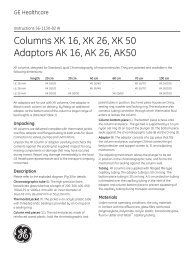
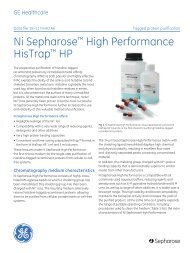
![[PDF] Sample preparation for analysis of protein, peptides and ...](https://img.yumpu.com/21549715/1/190x257/pdf-sample-preparation-for-analysis-of-protein-peptides-and-.jpg?quality=85)
![[PDF] Data File: rProtein A Sepharose Fast Flow](https://img.yumpu.com/21549316/1/190x253/pdf-data-file-rprotein-a-sepharose-fast-flow.jpg?quality=85)
![[PDF] MBP-tagged protein purification](https://img.yumpu.com/21548507/1/184x260/pdf-mbp-tagged-protein-purification.jpg?quality=85)
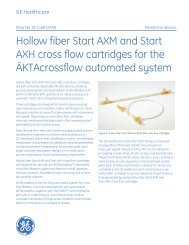
![[PDF] AKTA ready system Data file](https://img.yumpu.com/21540925/1/190x253/pdf-akta-ready-system-data-file.jpg?quality=85)
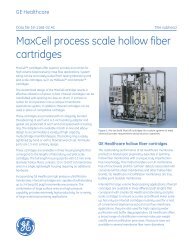
![[PDF] Data File - rProtein A/Protein G GraviTrap](https://img.yumpu.com/21539052/1/190x253/pdf-data-file-rprotein-a-protein-g-gravitrap.jpg?quality=85)
